Miltonia orchids: how to care at home
Miltoniae are perennial herbaceous plants from the Orchid family. In the wild, they grow in Brazilian forests along the Atlantic coast. Unusual colors of their flowers fascinate. Miltonia are epiphytes (they grow on other plants, but feed on their own), so they need special attention.
Botanical description of the plant
Miltonia refers to sympodial plants (its lateral shoots grow at about the same rate) with a height of not more than half a meter. Young shoots emerge from pseudobulbs (thickenings on the stem near the surface of the earth) 70–80 mm long and 40–50 mm wide.
The color of pseudobulbs and leaves varies from saturated light green with a yellowish tint to olive green, depending on the variety of the plant and the amount of sunlight received by it. The shape of the leaves is belt-shaped or linear-lanceolate. They are 35–40 cm long and 3 cm wide.
Orchid begins flowering by ejecting a long stalk, on which large flowers appear (with a diameter of about 10-12 cm). Their color is white, pink, purple, not uniform, but with a combination of several shades.

| Root system | fibrous-rod |
| Stem | shortened |
| Leaf shape | belt-shaped or linear-lanceolate |
| Leaf color | from saturated light green with a yellowish tint to olive green |
| Flower shape | zygomorphic, frontal inflorescence |
| Flower color | white, pink, purple |
| Fruit shape | box |
| Fruit color | green yellow |
Varieties
Miltonia orchid has several types, natural and artificial hybrids.
Let us describe some of them:
- Snow-white . This species is notable for its peduncles, reaching a length of 40 cm and decorated with loose erect tassels. Each brush has three to five flowers up to 90 mm in size. They are painted yellow with brownish-red spots. On the lower large petal (lip) of white color there are light purple or purple spots.
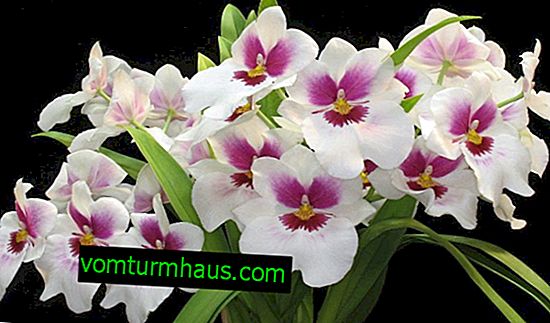
- Renelli . The owner of thin leaves with a slight glossy glare. Peduncles grow vertically and have white flowers with a light pink lip in purple-pink stripes.
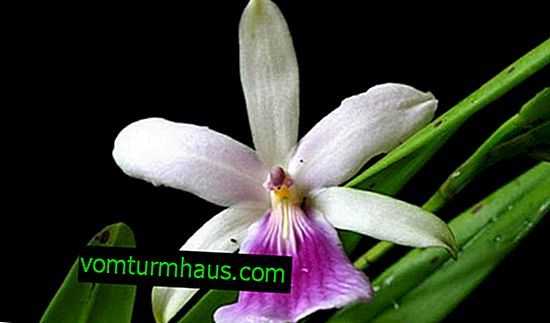
- Brilliant . Its flowers are up to 70 mm in diameter, white or cream in color with a raspberry core.
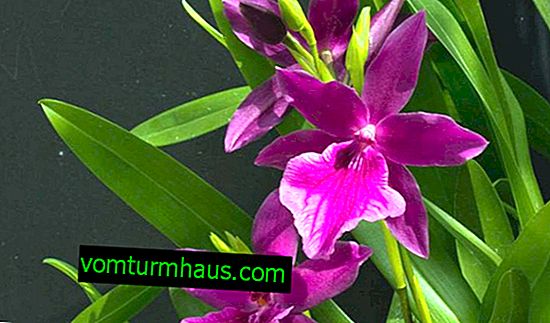
- Yellowish . Her buds are large, saturated color and very fragrant, collected in a brush. Petals wavy and with a pointed end. The core is dotted with bright stripes.
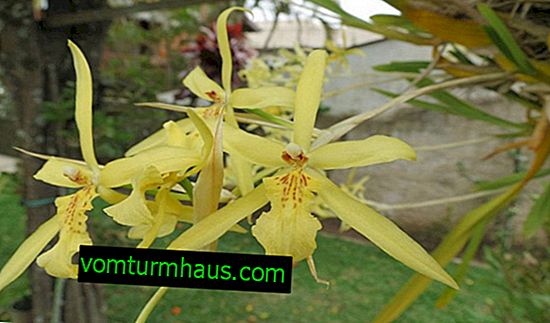
- Sunset Artificial hybrid with large flowers exuding coniferous-fruity-berry aroma. Bright yellow flowers with a transition in other colors.
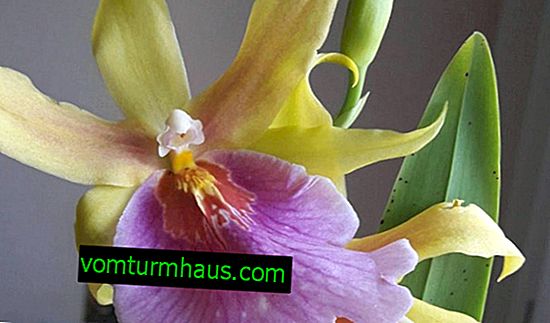
- Clouse . Another artificial hybrid, the owner of tiger flowers (a yellow background with brown stripes) with a snow-white lip, which has a light violet-purple hue at the base. Each inflorescence has 8–10 such flowers.
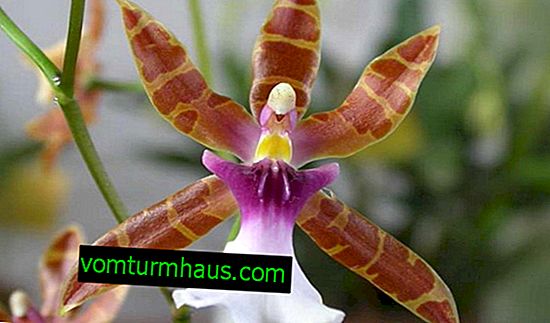
House growing conditions
In order for the orchid to please with beautiful flowering, you need to take care of creating suitable conditions for it.
Lighting
Miltonia prefer partial shade. The best place to place them is the west or east side. If the windows do not go in these directions, then you can put it on the southern windowsill, but you should definitely cover the plant from the burning sun.
The presence of a pink hue in the color of the foliage and the saturated colors of the flowers will indicate the correct choice of location.
Did you know? In 1837, the English botanist John Lindley received from his friends two copies of orchids, which differed from the genera of the Trichocentrum yellow and Oncidum that he had previously established. He realized that these flowers should be a new genus in the orchid family, and named him after Viscount Milton, a philanthropist and collector of orchids, Miltonia.
Ventilation
Ventilate the room regularly in the hot season so that the flower does not overheat. When airing, it is important that the orchid is not in a draft, since she really does not like them.
Temperature mode
Miltonia loves heat, but not heat, so in summer the temperature should not exceed +25 ° С. At night you can lower it by a couple of degrees.

Important! Sudden jumps in temperature are unacceptable.
Air humidity
Suitable humidity is 80–85%. Moreover, this indicator must be tried to maintain year-round. To ensure such a concentration of moisture in the air, a vessel with water or a tray with pebbles should be placed near the miltonia, which must be constantly moistened.
Home Care
Miltonia is a whimsical flower, so you need to carefully monitor its condition.
Watering
In spring and summer, you need to water the flower abundantly. The soil should not dry out. Irrigate a flower from a spray bottle with water at a temperature of +45 ° С. Such watering will remind the plant of tropical rain. After watering, you need to wait until all moisture drains, and wipe the foliage.
In winter, watering should be limited. The soil must dry well before it is moistened again.
Top dressing
Top dressing is applied during the growing season. A special mixture for orchids is used.

Important! For lush flowering, you need to use foliar top dressing with nutrient solutions.
Pruning
The pruning procedure is carried out regularly after the flowers fade. The peduncle is cut off completely with a secateurs or a sharp knife. Leaves do not touch, only if they do not begin to turn yellow.
Transfer
An orchid painfully responds to a transplant, therefore, this action should be performed only when the root system of the flower begins to fall out of the pot, and the flower itself slows down in growth. The pot is selected a size larger than the previous one.
You do not need to take a very spacious tank, since “freedom” has a bad effect on the growth of miltonia. It is filled with a substrate for orchids or a mixture of chopped fern roots, crushed moss, loose turfy soil and leafy soil, taken in equal proportions.
The bottom is necessarily lined with a layer of plastic drainage. It is desirable that the pot is plastic, transparent, without drainage holes, so that all moisture remains in it.
When transplanting, carefully remove the orchid from the old container, clean the root system of the soil. When a flower is moved to a new container, if it has young shoots, they do not need to be deeply buried in the soil.
Special period
Each plant has a flowering period and a dormant period. In each of these periods of time, special care is needed.

Bloom
Observing all the rules for care, you can enjoy the flowering of miltonia for a month or two. But if you make the maximum effort, then repeated flowering can begin after two months. At this time, the flower pot should be placed in partial shade, so that before lunch the rays do not burn the foliage. Watering and top dressing are carried out according to the schedule of the season.
Peace
Caring for an orchid after a flowering period is much more important than caring for during flowering, as it will depend on whether the flowers appear next year or not. The beginning of this period coincides with the maturation of pseudobulbs. At this point, young shoots usually catch up with the old ones.
With the manifestation of these changes, the pot with the plant must be moved to a cool place with a temperature not lower than +15 ° С. Dried flower stalks must be cut off. For dormancy, the dressing of the flower stops and watering is reduced to a minimum.
With the advent of new peduncles on the orchid, it is transferred to the light, the temperature is raised and they gradually begin to switch to the spring-summer regime of watering and top dressing.
Did you know? The last of the miltonia species known today was discovered by the collector of orchids Guido Pabst near the city of Sao Paulo in 1976. This species is called M. kayasimae.
Breeding
The flower propagates vegetatively. The procedure is carried out in the spring.

Division
This method involves the division of rhizomes. The procedure is performed during transplantation. It is very important that the mother plant had at least six pseudobulbs at the time of the procedure.
The flower extracted from the pot is cleaned of soil, and with the help of a knife, the root system is cut so that each part has at least three pseudobulbs. The slice is smeared with activated carbon powder, and the plants are planted in individual pots. They are placed in partial shade at a temperature of +25 ° C. Water the first time after a few days.
Kids
Reproduction by children or pseudobulbs is carried out in a similar way (when transplanting). A pseudobulb with well-developed roots is selected and separated from the mother plant with a sterile sharp knife. For rooting, they are placed in a container with moss. After they are planted in individual pots and create the same conditions as for reproduction by division.
It will also be useful for you to find out how to properly grow orchids from seeds at home, as well as what the composition should be and how to make the soil for orchids with your own hands.
Growing problems
In captivity, an orchid is often attacked by pests and various diseases. In addition, many flower growers are faced with such a problem as the lack of flowering.
Why does not bloom
Here are a few reasons why a miltonia stops flowering:
- temperature (sharp changes are allowed or it is not maintained at the proper level);
- lighting (direct sunlight is falling on the plant);
- watering (excessive irrigation and use of cold water);
- root system (it was violated during transplantation, due to the removal of a large number of roots, the plant can not be kept in loose soil).

- chemical treatment (use of growth stimulants for spraying);
- temperature (to provide smooth temperature jumps between daytime and nighttime);
- watering (arrange a flower for a small drought);
- fertilizers (feed with nitrogen);
- pruning (pruning of a peduncle near a sleeping kidney).
Diseases and Pests
For an orchid, it is extremely important to identify and eliminate a pest or a disease in time, since under their influence it quickly loses its decorativeness and dies.
To identify a threat in time, you need to know how it manifests itself:
- Thrips . These pests usually appear due to low humidity. They cover the foliage with white plaques, which leaves the leaves silvery.
- Shield . Its presence is indicated by brown plaques on the leaves and a sticky substance on them.
- Whitefly Because of it, the leaves become covered with yellow spots and gradually begin to fade, die.
You can get rid of all these insects with the help of a soap solution and insecticides (Fitoverm, Actellik, Substral).

As you can see, miltonia is a very moody flower. She requires close attention. Careful adherence to the rules will not only help to avoid problems with the plant, but also allow you to admire beautiful flowering for a long time. And it is worth the trouble that flower care brings.









